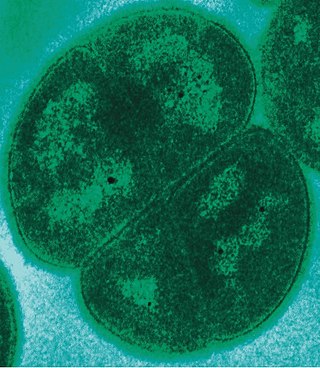热门问题
时间线
聊天
视角
抗輻射奇異球菌
奇异球菌科奇异球菌属细菌 来自维基百科,自由的百科全书
Remove ads
抗輻射奇異球菌(學名:Deinococcus radiodurans)又稱耐輻射奇異球菌,是奇異球菌屬的一種對輻射有免疫力的嗜極生物,可以承受能殺死人類3000倍和蟑螂無法抵抗的15倍輻射,也可在充滿輻射的外太空存活3年。該菌具有超強的DNA損傷修復能力以及多種高效抗氧化系統的協同作用,使其能夠在數小時內高效而精準地修復同一個基因組中產生的多達100個以上的DNA雙鏈斷裂[1][2]。
抗輻射奇異球菌最早是1956年輻照滅菌後仍腐敗的肉罐頭中分離得到的, 被命名為耐輻射微球菌(Micrococcus radiodurans),屬於微球菌屬,之後才歸為奇異球菌屬[3][4]。
Remove ads
名稱
耐輻射奇異球菌的學名Deinococcus radiodurans源自古希臘語δεινός(deinos)和κόκκος(kokkos)意思為「可怕的顆粒/漿果、野果」,以及拉丁語radius和durare,意思是「輻射存活(生存、倖存)」。該物種曾被稱為「耐輻射微球菌」。由於其堅韌性,它被暱稱為「細菌柯南」(Conan the Bacterium),取自蠻王柯南(Conan the Barbarian)。[5]
進化與起源
對具有超強輻射抗性的耐輻射奇球菌在進化上的認識存在不同的觀點。
「天外來客」說認為耐輻射奇球菌可能源自於其他星球,比如火星,隨着隕石等外來物質落入地球而在地球上出現[4]。這一假說最早由俄羅斯空間生物學研究中心的科學家於2003年在歐洲地球物理學會年會提出,並得到了一定的支持[4]。實驗證據顯示,耐輻射奇球菌在外太空環境中具有長期存活的能力,甚至可以承受長達45年的星際旅行[6][7]。此外,模擬火星表面環境的實驗也證實了耐輻射奇球菌對於極端環境的適應性[8]。
「乾旱協同進化」學說認為耐輻射奇球菌起源於地球,並在長時間的乾旱環境中逐步演化出了其超強的DNA損傷修復能力,從而形成了其抗輻射的特性[9][10]。這一學說得到了大量的研究支持,因為耐輻射奇球菌不僅在輻射環境下具備生存能力,還能在乾燥條件下長期存活[9]。其與其他在乾旱環境下生存的微生物表現出相似的特徵(如擬甲色球藻屬成員),進一步支持了這一假說[11]。
細胞結構
耐輻射奇球菌的單個細胞直徑約為1-2微米,為一種好氧、非致病菌,因其細胞中合成類胡蘿蔔素而呈紅色[4]。其細胞壁具有特殊的6層結構,成分與革蘭氏陰性菌相近,但不包含磷壁酸組分,在結晶紫染色後,很難使其脫色,呈現出革蘭氏染色陽性的特徵[4]。這種獨特的細胞壁結構被認為具有更強的抵禦電離輻射和紫外射線的能力[12]。在對數生長期和穩定期,耐輻射奇球菌的細胞通常以二連體或四疊體的形式存在,其四疊體具有碳水化合物外殼,起到了支撐和保護作用,幫助其適應極端環境[13]。
耐輻射奇球菌的基因組包含兩個主要的環狀染色體(Ⅰ號染色體約為2.65 Mb,Ⅱ號染色體約為412 kb)以及大小分別為177和46 kb的質體[14]。其基因組的GC含量高達66.6%,這種高GC含量在一定程度上維持了DNA結構的穩定[4]。耐輻射奇球菌的預測開放閱讀框中約有四分之一只存在於該菌或異常球菌屬中,推測其可能來自於不同未知物種的水平基因轉移[4]。在穩定生長期,耐輻射奇球菌四疊體的擬核部分顯示為異常緻密的環狀結構,這種結構被認為能夠阻止電離輻射所造成DNA碎片在修復過程中的彌散,使得修復更為有效[15][16][17]。同時耐輻射奇球菌在不同的生長時期具有4-10個基因組拷貝,能夠為DNA損傷修復提供更多的修復模板[18]。
耐輻射奇球菌的細胞中金屬錳離子濃度高達0.2-3 mmol/L,並且具有非常高的錳鐵比[19]。與其他輻射不耐受的細菌相比,其細胞內的這種高水平錳鐵比與生物的輻射抗性成正相關[20][21]。錳離子通過多種途徑幫助耐輻射奇球菌抵禦高劑量的電離輻射,包括維持細胞擬核的高度濃縮狀態、降低細胞中的氧化水平以及激活DNA損傷修復蛋白和抗氧化酶的活性[20]。
Remove ads
DNA修復機制
高劑量電離輻射會導致大量的DNA損傷,其中雙鏈斷裂(DSB)是最為嚴重的類型之一[4]。在耐輻射奇球菌中,DNA修復主要分為兩個階段。
- DNA損傷的響應
- 細胞需要在轉錄水平上對DNA損傷進行響應,以啟動重組修復途徑[4]。在一般的原核細胞中,存在一種稱為「SOS應答機制」的模型,其中單鏈DNA與RecA蛋白形成複合物,促進阻遏蛋白LexA的自切割反應,從而激活DNA修復基因的轉錄[22]。然而耐輻射奇球菌中不存在具有活性的LexA蛋白,而是通過轉錄因子DdrO蛋白和金屬依賴蛋白酶PprI介導的新型轉錄遏制去除機制來響應DNA損傷[23][24][25]。PprI蛋白的琥珀酰化修飾可以調控其蛋白酶活性,進而影響DdrO蛋白與啟動子的結合,從而調控DNA修復基因的表達[26][27][28]。此外,耐輻射奇球菌還編碼了一系列的新型轉錄因子,如毒素-抗毒素系統和drRRA等,參與了細胞內的DNA損傷響應過程[29][30][31]。
- DNA損傷的切除
Remove ads
抗氧化系統
耐輻射奇球菌的抗氧化系統主要包括抗氧化酶系統和非酶類機制。抗氧化酶系統包括超氧化物歧化酶、過氧化物酶和過氧化氫酶,這些酶能夠高效清除ROS(活性氧自由基)[4]。儘管這些蛋白的功能有一定的重疊,但它們在耐輻射奇球菌中的表達水平明顯高於其他微生物,能夠具有更強的抗氧化能力[36]。
非酶類抗氧化系統包括類胡蘿蔔素、吡咯喹啉醌和Dps蛋白等[37][38][39]。類胡蘿蔔素在耐輻射奇球菌中具有較強的自由基清除能力,其合成通路已被完全鑑定[4]。其中,八氫番茄紅素合成酶是該通路中最關鍵的蛋白之一,其缺失將導致耐輻射奇球菌無法合成類胡蘿蔔素,從而降低其對電離輻射和氧化脅迫的抗性[40][41]。
應用
耐輻射奇球菌的重組修復途徑與真核細胞同源,因此被視為重要的模式生物之一,其易於培養、操作方便的特點使其成為DNA修復研究的理想對象[4]。耐輻射奇球菌中的光敏色素DrBphP能夠用作單體紅外熒光蛋白,可用於疾病探查[42]。
耐輻射奇球菌具有超強的輻射抗性,使其在放射性核素和重金屬污染治理方面具有天然優勢[43]。通過表達異化型亞硫酸鹽還原酶等生物修復工程,可以將可溶性的六價鈾還原為不可溶的四價鈾,實現對鈾的有效富集[44]。將汞還原酶基因導入耐輻射奇球菌,使其能夠耐受高濃度的汞脅迫,並將其還原為更安全的形態[45]。工程改造的耐輻射奇球菌還能夠對鈷、鍶、砷等重金屬進行生物吸附[46][47][48]。
參考文獻
外部連結
Wikiwand - on
Seamless Wikipedia browsing. On steroids.
Remove ads

